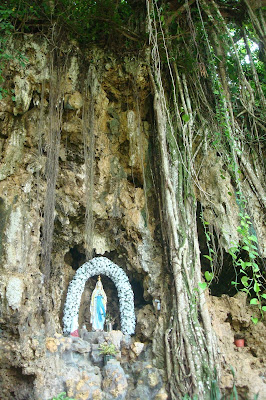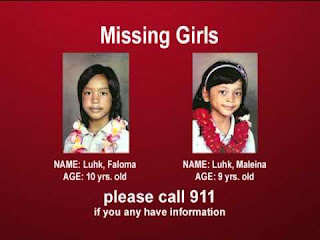By 1795, we had then what we have now.....a new kind of Chamorro race based on the blood lines of those who lived here before European contact, mixed now with the blood of people from Spain, Latin America, the Philippines and a few from other places.
The soldiers of Guam had been formed into two separate companies based on racial lines.
The Spanish Infantry (Infantería Española) included people from Latin America, more than likely from Mexico most of all, but it is not impossible that there were some from other countries of Latin America (we know that Governor Esplaña was from Peru) and perhaps even from Spain itself, though normally the only Spaniards from Spain on Guam in those days were the high officers and the missionary priests.
The Pampanga Infantry (Infantería Pampanga) included Filipinos from Pampanga, a province of the Philippines not far from Manila, having its own language distinct from Tagalog. This group of soldiers could have had some men from other parts of the Philippines as well, but the majority would have been from Pampanga.
In short time (1670s), these foreign men began marrying Chamorro women. Then they started marrying among themselves : Chamorro, Latin American and Filipino blood all mixing together. This happened mainly in Hagåtña, where the soldiers lived, while the outlying villages had but a few soldiers posted there and were populated by Chamorros who more slowly intermarried with foreigners.
In 1795, the soldiers were still classified as belonging either to the Spanish Infantry or the Pampanga Infantry, but they were all, in the main, Chamorros as we understand the term today : the descendants of the pre-contact people, mixed with foreign blood. In fact, you can find some indigenous Chamorro names in this list such as Aguon, Materne and Achuga.
NOTE : I am keeping the spelling of the names as found in the original document, with the modern spelling in parenthesis.
Achuga, Rafael
Acosta, Patricio
Aguirre, José Antonio
Aguon, Víctor
Anungui, Francisco
Arceo, Desiderio
Arceo, Félix
Arceo, Francisco
Arceo, Leopoldo
Basa, Remigio (Baza)
Basa, Victorino (Baza)
Bermejo, José
Borja, Enrique de
Calderón, Pedro
Camacho Francisco
Cárdenas, (first name illegible)
Castro, Ignacio de
Castro, Nicolás de
Cotino, Pedro
Cruz, Felipe de la
Cruz, Félix de la
Cruz, Francisco de la
Cruz, José de la
Cruz, Justo de la
Cruz, Salvador de la
Díaz, Pedro
Dimapan, Ignacio (Demapan)
Dueñas, (first name illegible)
Dueñas, Feliciano
Dueñas, José Romano
Espinosa, Ignacio
Flores, Juan Crisóstomo
Flores, Rosario
Fránquez, Florentino
Fránquez, Rufino
Garrido, José
Garrido, Manuel Tiburcio
Guerrero, Juan de Dios
Guevara, José Andrés
León, Luís de
Lima, Joaquín de
Lizama, José
Lizama, Nicolás
Manibusan, Gregorio
Manibusan, Juan
Manibusan, Martín
Materne, José
Mendiola, Paulino
Mendiola, Tomás
Mendiola, Vicente
Ojeda, Manuel de
Pablo, Juan Regis
Palomo, Antonio
Pangilinan, Gaspar (Pangelinan)
Pascual, Andrés
Pascual, Francisco
Quintanilla, Nicolás de
Ribera, Diego de (Rivera)
Rivera, Marcos de
Rodríguez, José
Rosa, Domingo de la
Rosario, Remigio del
Sánchez, Andrés
San Nicolás, Dámaso de
Santos, Antonio de los
Santos, Mariano de los
Sarmiento, Juan
Sigüenza, Ignacio
Taytano, Juan (Taitano)
Tello Ximenez, Andrés (Jiménez)
Torres, Juan Francisco Regis de
Ulloa, José de
Vega, Antonio de la
Zablan, Augustin Roque (Sablan)
Zepeda, Nicolás (Cepeda)
NOTES ABOUT SOME NAMES
Crisóstomo. In this case, this was not a last name. Crisóstomo is the Spanish form of Chrysostom, the full name of Saint John Chrysostom. That is why this man's name is "Juan Crisóstomo." What was interesting is that, in the list, his name is abbreviated using the Greek form for the first two letters : xptomo.
Tello Ximenez. Tello would be the paternal surname; Ximenez the materanl. In Spanish, X (before a vowel) would have the same sound as a J (before a vowel). Think of México. The Tello surname continued in Guam till the late 1800s into the early 1900s but then died out, being all women.
De. Many of the surnames began with "de," meaning "of," or "del" (of the, masculine) or "de la" (of the, feminine) or "de los" (of the, masculine plural). Most families dropped all of these in order to shorten their names. The de la Rosa family did not drop it.
Pangilinan. In Spanish, a G before an I or an E would sound the same. The G would sound like an H. Pan - hi - li - nan. The name is from Pampanga where there still are many Pangilinans and they spell it this way. In the Marianas, the Chamorro descendants of their Pangilinan/Pangelinan ancestor moved in time to the GE form of Pangelinan.
Augustin. The first name of the only Zablan on the list. In modern Spanish, it is spelled Agustín.
Zablan. In the Spanish spoken in Latin America, the Philippines and the Marianas, the Z sounds like an S in all cases. That is why, in the past, it was sometimes spelled Zablan or Sablan. Both sounded the same.
Basa. See above, about Zablan, that explains why at times it was spelled Basa and at other times Baza.
Zepeda. See above, about Zablan, that explains why at times it was spelled Zepeda and at other times Cepeda.
Regis. Some people might mistake this for Reyes. It is not Reyes. There was a Jesuit saint named John Francis Regis. Since the first missionaries here were Jesuit priests, John Francis Regis (Juan Francisco Regis), or a version thereof, was a name often given to boys.
Taytano. In Spanish, Y and I have the same sound, so at other times it was spelled Taitano, the form which soon became the exclusive way to spell it. This is why at times you see Ynés/Inés, Ypao/Ipao and so on.
Joseph/
Josef. The original is the Latin Joseph or Josephus. Later, the Spaniards shortened it to José, dropping the PH or F. I have my suspicions that, even when it was spelled with a PH or F, it was pronounced José by the 1600s.
Dimapan. Later it became spelled Demapan. This Guam family moved to Saipan.
Ribera. In Spanish, the V and B before a vowel sound the same, closer to a B. The Victorino Basa listed above was actually spelled Bicturino but I couldn't bear to repeat that spelling in the list.
Rosario. There is a man named Rosario, which might surprise some people because we take it as a woman's name. People named Rosario are named after Our Lady of the Rosary. The word
rosario actually means "rosary" so, although not often, the name is also given to men. Other names considered "female" but which are sometimes given to men are Trinidad (for the Trinity) and Nieves ("snows," in honor of Our Lady of the Snows).
Juan de Dios. Literally, "John of God," was the name of a saint.
NOTES ON SOME PERSONAGES
Augustin Roque Zablan. Sablan, or Zablan, does not appear in the Marianas records till after 1758, so this may have been one of the first Sablans in the Marianas, or the son of one of the first.
Juan Francisco Regis de Torres. Son of a Spaniard (José Miguel de Torres) and Dominga Josefa Espinosa. He married a Chamorro. A very high official in the colonial government.
Manuel Tiburcio Garrido. His name appears in many Marianas documents, having been a government clerk.
Justo de la Cruz. Justo served many years in the Spanish colonial government in a variety of offices.
Dámaso de San Nicolás. This last name does not appear in the Marianas records till after 1758 and, as shown in some baptismal records, was given by some Augustinian Recollect priests (who arrived only in 1769) to some illegitimate children. Saint Nicholas of Tolentine was a patron of these Recollect priests, so it is no surprise they wanted to name some babies after him.
SURNAMES THAT DISAPPEARED
At least among the Chamorro population. There may be families living on Guam now with these last names, due to more recent migration.
Aguirre
Achuga
Anungui
Bermejo
Calderón
Cárdenas
Cotino
Jiménez
Lima, de
Pascual
Tello
Vega, de la





































